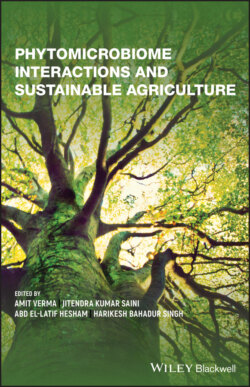Читать книгу Phytomicrobiome Interactions and Sustainable Agriculture - Группа авторов - Страница 23
2.3 Phytomicrobiome: The Communication via Signaling
ОглавлениеThe phytomicrobial associations are very comfortably established between the plant and the microbes through the exchange of signals as a form of communication. The orchestration of signals occurs not only between the host plant and microbial species but also among the microbial species present in a consortium. Appropriate signaling may prevent an unfavorable association by eliciting the defenses against the pathogenic invasions. Signaling governs each other's activity in the consortium as well as the community (Engelmoer et al. 2014). In the event of chemical signals within the community aids positive association for the benefit by enabling the residence of endophytes (Hartmann et al. 2014) and prevents futile or harmful associations.
The microbes in the association of the host have a signature sequence at the molecular level which is highly conserved for that species. The term associated with this phenomenon is known as microbe‐associated molecular patterns (MAMP). These molecular receptors present on the microbial species are recognized by pattern recognition receptors (PRR) which are also the ligand‐binding ectodomains in plants. The best‐known example of this MAMP is where the bacterial species have flagellin and chitin is specific to fungi (Newman et al. 2013). MAMP has one of the highlighting features in establishing plant immunity as well as eliciting antibiotic secretion in microbes. Bacterial species have also been known to interfere with signaling between plants and other strains of microbes. In order to enable pathogenic association, Bacillus strains have been shown to minimize the favorable MAMP‐regulated immune response which may also hinder the secretion of antibiotic substances to enable and establish an infection successfully.
These chemical signals may also be termed as the stress signals, which, as the name suggests, are generated in the course of a stressed situation for the growth of the plant. These signals shall in turn elicit the microbial signal which prepares the microbe to provide aid to the stressed plant by its metabolic activity. Signaling compounds produced are either primary metabolic compounds such as carbohydrates, organic acids, and proteins; as well as secondary metabolites such as phenols, phytohormones, and flavonoids, etc. Microbes to host plant signaling compounds include compounds such as phenols, peptides, plant hormones, acyl homoserine lactones, etc., which can also act as microbe to microbe signal. The major contribution in the selection of microbial consortia around the roots happens by the secretions of compounds by the root exudates. Arabidopsis thaliana releases malic acid in defense of the attack by the foliage pathogen which stimulates the production of beneficial biofilms in the rhizosphere (Rudrappa et al. 2008).
